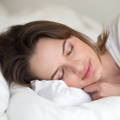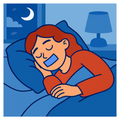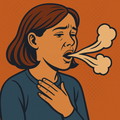Snoring, Apnea, Mouth Breathing, Feeling Tired?
“Current literature demonstrates that myofunctional therapy decreases AHI by approximately 50% in adults and 62% in children.”
Sleep-Disordered Breathing in Adults: A Natural Approach to Better Sleep and Health
Why Breathing Matters at Night
Sleep isn’t just rest — it’s when your body heals, your brain processes memory, and your hormones regulate. But if your airway is blocked or your breathing is dysfunctional during sleep, your body enters a state of stress instead of repair. This can lead to:
- Grinding or clenching
- Chronic fatigue and brain fog
- Hormonal imbalance
- Anxiety and mood issues
- High blood pressure
- Worsening asthma or reflux
- Snoring and sleep apnea
Many of these symptoms stem from something surprisingly overlooked: your oral posture and airway function — especially how you breathe while sleeping.
How Orofacial Myofunctional Therapy Helps
- Reduces snoring and dry mouth at night
- Improves nasal breathing and comfort
- Opens your airway: Tones the tissues and muscles in your mouth, nose, and throat
- Retrains your sleeping
- Feel more rested and alert during the day
- Easy facial exercises with a big impact
- Breathe better, sleep better, think better
- Increase memory and healing/recovery
The Link Between Mouth Breathing, Facial Structure, and Sleep Quality
Breathing through your nose activates your diaphragm and supports oxygen delivery. Mouth breathing, on the other hand, reduces oxygen intake by 10–20%, dries the airway, and leads to disrupted sleep.
Over time, chronic mouth breathing can contribute to:
- Underdeveloped jaw or facial structure
- Tongue posture that blocks the airway
- Poor muscle tone in the throat and face
- Upper airway resistance or collapse
In adults, this often presents as snoring, insomnia, fatigue, or a diagnosis of mild to moderate sleep apnea or ADHD — even if you don’t realize your breathing is the problem.
Tired all the time?
No matter the length of sleep,
wake up tired. Never feel rested.
brain fog/Memory Troubles?
Decreased productivity.
Increased stress. Depression.
Neck/Upper back pain?
Mouth rests open. Poor posture.
Tired Eyes.
Night time Dry mouth?
Frequent cavities. Headaches.
Weakened immune system.
Tired, foggy, waking with dry mouth or snoring? Simple exercises help you breathe and sleep better.
What Is Orofacial Myofunctional Therapy?
Orofacial Myofunctional Therapy (OMT) is a natural, exercise-based therapy that retrains your facial and airway muscles to support proper breathing — especially during sleep.
Through a customized plan, we work to:
* Restore nasal breathing
* Train the tongue to rest in the correct position
* Improve soft palate and airway muscle tone
* Strengthen the muscles that help keep the airway open at night
* Support alignment, posture, and facial function
These changes can reduce snoring, lower CPAP pressure needs, and address the root causes of disordered breathing — not just the symptoms.
How We Help You

Free Consultation:
Delve into your symptoms. Learn more about your situation.
Meet our Orofacial Myologists.
Find out about the programs.
In-person or online.
New Patient Exam:
Thorough comfortable Exam & Assessment.
Diagnosis & Treatment planning.
Start program best suited to your disorders.
2 hours.
Programs:
Daily easy facial exercises.
Tones muscles and tissues of the face, mouth, throat & airway.
Our Program: What to Expect
Free 45-Minute Consultation
We explore your symptoms, habits, and airway function to see if myofunctional therapy is a good fit.
2 - Hour New Patient Exam
This includes a full muscle function assessment, sleep symptom review, breathing screen, and detailed photos/videos to guide diagnosis and planning.
Personalized Therapy Plan
You’ll receive a tailored program of guided facial, tongue, and breathing exercises, usually practiced for 5–10 minutes twice a day. Sessions can be in-person or virtual.
Progress Tracking
We check in at each session to review symptoms, track progress, and adjust the plan as your airway improves.
The Why & How of Orofacial Myofunctional Therapy

What we do
Neuromuscular re-education in Orofacial Myofunctional Therapy involves training and re-patterning the muscles for better oral and facial function. It corrects improper muscle habits, improves coordination, and promotes a healthier orofacial system. Through targeted exercises, it enhances muscle control, strength, and coordination, leading to improved overall well-being.
How we do it
By focusing on the muscles and tissues of the upper airway, the tongue, jaw, face, head, and neck, we utilize tailored exercises to tone or relax these areas. We address the disorder from its foundation, rather than using a band-aid approach. Our goal is to facilitate lasting positive change by resetting detrimental habits and targeting the root cause of the issue.
By focusing on the muscles and tissues of the upper airway, the tongue, jaw, face, head, and neck, we utilize tailored exercises to tone or relax these areas. We address the disorder from its foundation, rather than using a band-aid approach. Our goal is to facilitate lasting positive change by resetting detrimental habits and targeting the root cause of the issue.
Best age to start
All ages (6 months+) can benefit from our services. While children tend to experience significant impact due to the adaptability of their oral-facial structures during the growth stage, adults can also greatly benefit from targeted muscle toning and relaxation. This can significantly improve the aging process and enhance the quality of life in their senior years. It's never too late to make a positive difference in your health.
Free Consultation
Everyone is eligible for a free consultation, regardless of age. This provides an excellent opportunity to have your questions answered and meet your Orofacial Myofunctional Therapist in Ottawa, ON.
What Does the Research Say?
Recent studies support the use of myofunctional therapy for sleep-disordered breathing:
- A 2020 systematic review published in Nature and Science of Sleep concluded that OMT significantly reduces AHI (Apnea-Hypopnea Index) in patients with mild to moderate sleep apnea.
- A 2021 clinical trial found that patients who performed daily myofunctional exercises had less snoring, more daytime energy, and improved tongue tone compared to those using CPAP alone.
- Myofunctional therapy is now recognized by sleep dentists, ENT specialists, and airway-focused orthodontists as a valuable adjunct to conventional treatments.
Ready to Breathe Better, Sleep Deeper, and Feel Rested?
We work with adults in Ottawa and beyond who are ready to take control of their health and sleep naturally. Whether you’re exploring alternatives to CPAP, curious about mouth breathing, or just want better sleep, our team is here to help.
Book your free consultation today to find out if myofunctional therapy is right for you.
By Oct 12, 2025
By Oct 01, 2025
By Aug 10, 2025
By Jul 10, 2025
By Jul 05, 2025
By Jul 01, 2025






